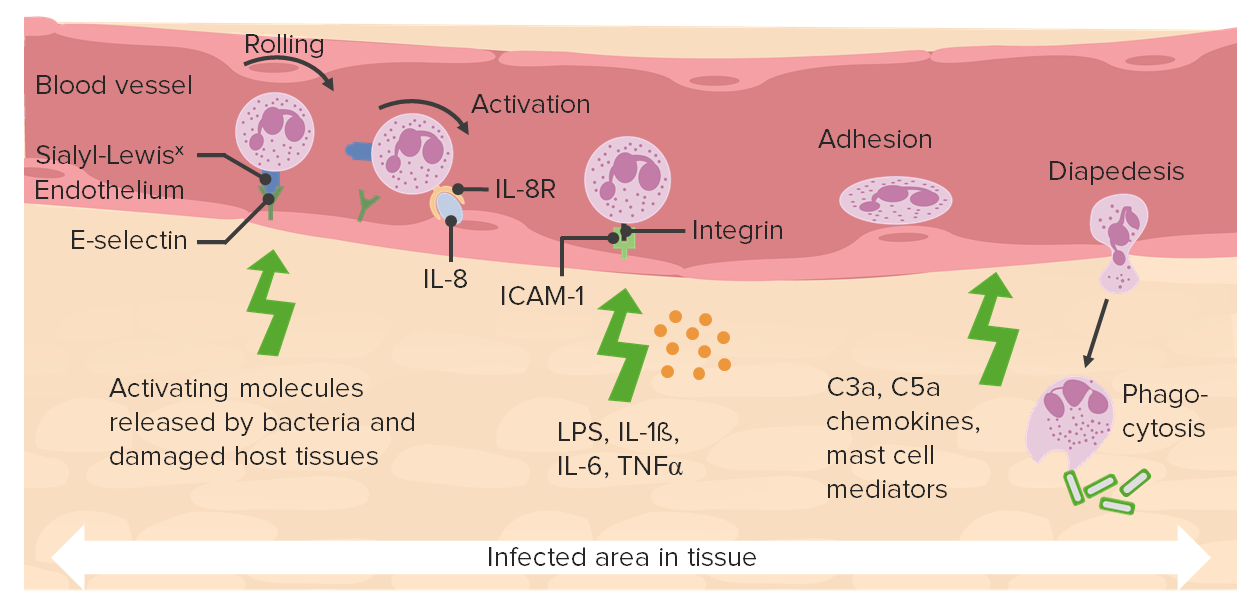Playlist
Show Playlist
Hide Playlist
Kinin and Coagulation Factors – Protein Effector Cascades
-
Slides Acute and Chronic Inflammation Effector cascades.pdf
-
Download Lecture Overview
00:01 Let's look at kinins and coagulation factors which are very intimately linked. 00:05 And we're starting with a simple dot at the beginning. 00:09 It gets to be a fairly complex series. 00:12 So hang in there. 00:13 Again, feel the force, kind of get a feeling for this without getting too bogged down in all the details. 00:21 So factor XII is technically part of the coagulation cascade, it's called hageman factor. 00:26 So factor XII can be by a variety of molecules activated. 00:31 In factor XII interacts with collagen, or basement membrane, or activated platelets in the presence of a cofactor, called high molecular weight kininogen we will activate it, we will turn it into an active protease. 00:47 So this is beginning of a cascade and activated protease. 00:51 And whenever we activate coagulation factors, as we'll talk about in a subsequent set of topic discussions, we label it A. 01:00 So this is factor XIIa, meaning that it's activated. 01:04 Factor XIIa will do a variety of things. 01:07 On the right hand side, it will feed into the clotting cascade. 01:12 And we'll show more of that in just a second. 01:15 It will also feed into the kinin cascade. 01:18 So that proteolytic activity of activated XIIa will act on a variety of other proteins that are present, either in the circulation or in tissues. 01:29 Let's look specifically at clotting. So this is the coagulation cascade. 01:34 So downstream from XIIa You see XIIa at the very beginning, and it will act on factor XI to XIa there are a whole bunch of things. 01:43 We'll come back to this because we'll spend more time in a subsequent topic discussion. 01:48 But the main goal here is to activate prothrombin, which is factor II, to an activated form IIa, that will cleave fibrinogen to fibrin and we get a clot. 01:59 Great. 02:00 So we're getting down that cascade because we activated factor XIIa at the very beginning. 02:08 Interestingly, thrombin does more than just cleave fibrinogen to fibrin to make a clot. 02:15 It also is very pro inflammatory. 02:17 And we will in the clotting cascade talk later about this pro inflammation aspect of thrombin. 02:26 So thrombin activates inflammatory pathways. 02:28 And that's all we really care about right now. 02:30 So we've gotten XII, XIIa coagulation and we're also getting pro inflammatory effects. 02:38 Just hang on to that. 02:39 The details not important. Concept really cool. 02:42 Okay, back over. 02:44 The other thing that XIIa can do is activate the kinin cascade. 02:47 So it's going to proteolytically cleaved prekallikrein to kallikrein Bunch of words. 02:53 But in fact, now kallikrein is going to do one other element that we haven't really talked about yet, in all this inflammatory stuff. 03:01 And that's pain. 03:03 Kallikrein choose on high molecular weight kininogen, HMWK to make bradykinin. 03:10 And bradykinin is a major pain mediator. 03:13 It also mediates permeability. 03:16 But kallikrein is going to get us into the pain pathway, which is part of the cardinal features of inflammation. 03:24 Cool. 03:25 Kallikrein will also start to counter regulate the clotting cascade. 03:31 So, again, that truism for every pro, there's an anti. 03:35 Well, we have procoagulant on the right hand side, and we have anticoagulation being driven on the left hand side, all through the same concurrent activation to XIIa. 03:47 So we will activate plasminogen, cleave it to plasmin. 03:51 And that will break down fibrin. 03:54 So that we can limit the amount of clot. 03:57 This becomes very important because we don't limit it, you can potentially clot the entire vasculature with just the initial activation of XII to XIIa. 04:08 So kallikrein also activates a fibrinolytic system, in addition to mediating pain through bradykinin. 04:15 And plasmin, which got activated through kallikrein is now going to drive the complement cascade. 04:21 Whoa, all this stuff is interrelated. 04:25 And it's all part of a cascade. 04:28 So take this picture, just see the colored boxes and the bold font. 04:35 The details not too important, but the concepts here of the interrelationship of these cascades really important.
About the Lecture
The lecture Kinin and Coagulation Factors – Protein Effector Cascades by Richard Mitchell, MD, PhD is from the course Acute and Chronic Inflammation.
Included Quiz Questions
Which of the following activates factor XII?
- Endothelial collagen
- Macrophages
- Complements
- Kinin
- Prothrombin
Which of the following is involved in the mechanism of pain in inflammation?
- Kinin cascade
- Coagulation cascade
- Complement cascade
- 5-lipoxygenase cascade
- Leukocyte adhesion cascade
Thrombin is produced by the enzymatic cleavage of prothrombin by...?
- ...activated Factor X (Xa).
- ...activated Factor XIII (XIIIa).
- ...activated fibrin.
- ...activated protein C.
- ...activated protein S.
Customer reviews
5,0 of 5 stars
| 5 Stars |
|
5 |
| 4 Stars |
|
0 |
| 3 Stars |
|
0 |
| 2 Stars |
|
0 |
| 1 Star |
|
0 |




